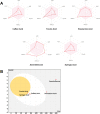Kidney injury and oxidative damage alleviation by Zingiber officinale: pharmacokinetics and protective approach in a combined murine model of osteoporosis
- PMID: 35462952
- PMCID: PMC8995235
- DOI: 10.1007/s13205-022-03170-x
Kidney injury and oxidative damage alleviation by Zingiber officinale: pharmacokinetics and protective approach in a combined murine model of osteoporosis
Abstract
Ginger (Zingiber officinale) is considered as a nutraceutical spice, which possesses several health promotion and benefits. This study was carried out to investigate the phyto-chemical composition, the antioxidant capacities, the drug-likeness, and pharmacokinetic properties of ginger extract on kidney injury-associated osteoporosis in rats. Phenolic and flavonoid contents were assessed by standard chemical analysis methods and HPLC. In vivo protective effect was based on the use of female rats to evaluate the effect on renal injury as a result of combined osteoporosis using biochemical markers, oxidative status, and histological analyses. Results showed that ZO contained appreciable amounts of phenolics and flavonoids and it exhibited high scavenging activity. Ovariectomy-associated corticotherapy induced severe renal injury marked by altered biochemical markers (creatinine, urea, and uric acid), reduced GFR, significative oxidative damage signs, and disrupted antioxidant status in the combined osteoporotic rats. The histopathological examination revealed structural modifications of kidney tissues. However, all these changes were reversed following the use of ZO. These results confirm the renoprotective and antioxidant potential of ginger against renal injuries in osteoporotic rats.
Keywords: Drug-likeness; Ginger; Histopathology; Kidney function; Pharmacokinetics.
© King Abdulaziz City for Science and Technology 2022.
Conflict of interest statement
Conflict of interestThe authors declare that they have no conflicts of interest in the publication.
Figures





References
-
- Aebi H (1984) [13] Catalase in vitro. In: Methods in Enzymology. Academic Press, pp 121–126 - PubMed
-
- Akyol S, Ugurcu V, Altuntas A, et al (2014) Caffeic acid phenethyl ester as a protective agent against nephrotoxicity and/or oxidative kidney damage: a detailed systematic review. In: Sci World J https://www.hindawi.com/journals/tswj/2014/561971/. Accessed 24 Dec 2020 - PMC - PubMed
LinkOut - more resources
Full Text Sources

